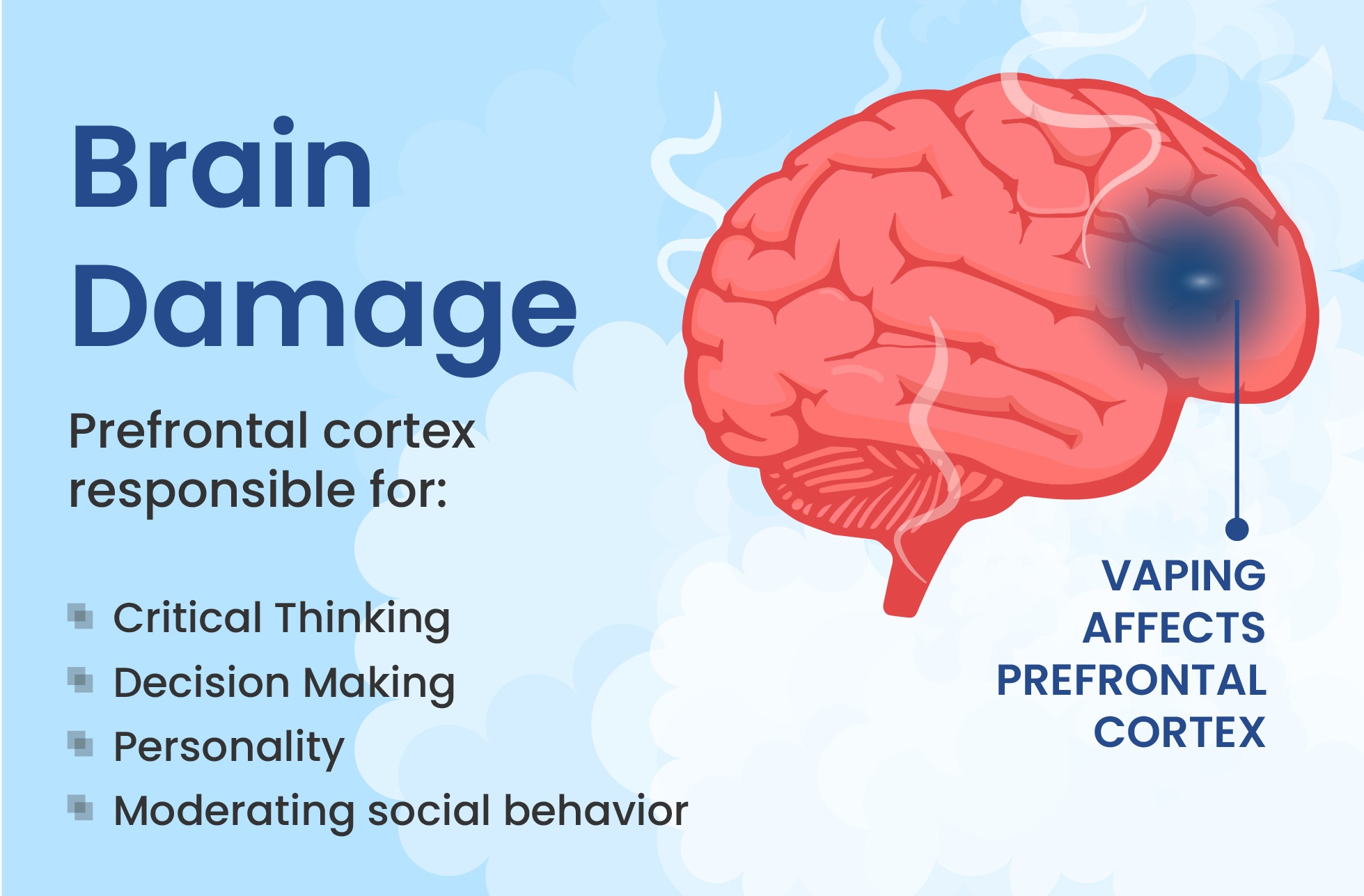MORE THAN JUST BLOWING SMOKE: THE REAL RISKS OF VAPING Whether you’re a regular or former smoker, a smoker who’s trying to quit or you’ve never lit up in your life, you’re probably familiar with vaping, the popular term for the use of electronic cigarettes, or e-cigarettes. Also known as

Whether you’re a regular or former smoker, a smoker who’s trying to quit or you’ve never lit up in your life, you’re probably familiar with vaping, the popular term for the use of electronic cigarettes, or e-cigarettes. Also known as “electronic nicotine delivery systems,” e-cigarettes were first introduced in the U.S. in 2007 to help adult smokers kick the habit. The devices come in many forms and sizes and can look like, among other things, a cartridge, pen, USB drive or cigarette. However, despite the term “vaping,” e-cigarettes don’t actually produce a vapor. Instead, they work by heating a solution of nicotine, flavoring and chemicals into an inhalable aerosol which, unlike vapor, can hold tiny chemical particles. E-cigarettes don’t contain tobacco, and because of this, they hit the market with heavy advertising touting the products as “safer” alternatives to traditional cigarettes, especially for those who are trying to quit smoking.
The hype worked. E-cigarettes are now a $3.7-billion retail market, with Juul, an e-cigarette brand launched in 2015, accounting for almost 70 percent of all sales (1). So, what’s the problem? Not only is research showing that e-cigarettes are nowhere near as harmless as first believed, young people, drawn in part to the wide variety of flavor solutions available – flavors with names like “Tootsie Roll,” “Candy Crash,” “Blue Razz Lemonade,” and “Buttered Popcorn” — are now more likely to vape than adults.
From 2011 to 2015, the use of e-cigarettes grew an alarming 900 percent among high school students (2). From 2017 to 2018, e-cigarette use increased 78 percent among high school students, and in 2018, more than 3.6 million U.S. youth, including 1 in 5 high school students and 1 in 20 middle school students, reported using e-cigarettes (3). This has led to lawsuits against manufacturers and efforts by the FDA and local and state governments to restrict the sale and use of e-cigarettes among minors. Juul and other manufacturers have responded with actions of their own including restricting sales of flavors that appeal to youth and ad campaigns stressing that their products are intended for adult smokers only.
But no matter the age of the user or the reason for vaping, it’s important to know that Juul and other e-cigarettes are not innocuous alternatives to cigarettes. Vaping solutions might not contain tobacco, but they do contain nicotine – for example, a single JUUL pod can contain as much nicotine as a pack of 20 regular cigarettes and delivers nicotine 1.25–2.7 times faster than competing e-cigarettes (4). The solutions also can be full of other harmful chemicals with names like “diacetyl,” “acetoin” and “propylene glycol,” a sweet-tasting chemical that is the main ingredient in your car’s antifreeze (5). These toxins can affect the brain, lungs, cardiovascular system and other parts of the body. Research is also showing vaping is addicting and can lead to regular tobacco use and have the same second-hand smoke effects as cigarettes.

Got nicotine and heavy metals? Your e-cigarette probably does. Most vaping liquid contains nicotine, sometimes with concentrations as high as 3 to 5 percent. Although nicotine is damaging to everyone, what it does to the brain makes the popularity of vaping among young people particularly worrisome.
Nicotine exposure impacts learning, memory and attention and can harm the adolescent brain, which continues to develop until about age 25 (6). Nicotine use is linked to damage of the prefrontal cortex, the part of the brain responsible for impulse control, emotions and decision making and one of the last brain areas to mature, and its use during adolescence increases the risk of developing psychiatric disorders and cognitive impairment later in life (7).
In addition, a recent study that analyzed the transfer of metals from e-cigarettes’ heating coils to the liquid solution and aerosol found that half of the 56 devices tested produced vapor that contained lead, a neurotoxin which can lead to brain and nerve damage, at levels above federal government limits. The study also found about 40 percent of the vaping samples contained a metal called manganese, which has been linked to brain deterioration, at levels above what the EPA considers safe. Half the samples also contained unsafe levels of chromium, a carcinogen or cancer-causing agent, and more than 10 percent of samples contained arsenic (8).
While it’s true e-cigarette liquid doesn’t contain as many chemicals as tobacco cigarettes, the solutions still can contain a potpourri of toxins that can lead to lung damage. The American Lung Association released a recent advisory stating that the organization is “very troubled by the evolving evidence about the impact of e-cigarettes on the lungs.” The ALA cites research that includes (9):

In addition, a study that appeared in the American Journal of Physiology in Oct. 2018 found that exposure to e-cigarette vapor can trigger inflammatory responses and adversely affect the respiratory system. Researchers also found that in many cases, the added flavor exacerbated the detrimental effects of e-cigarette vapor and concluded that both vaping and conventional cigarette smoking negatively impact lung biology (10).

Because vaping has only been popular for around 10 years, studies on its cardiovascular effects have had to focus on short-term use. Though these studies have shown early vascular function changes in those who vape, there are still no long-term human studies. However, a recent study published in the Journal of Applied Physiology that used animal models to mimic long-term human exposure to e-cigarette vapor found that chronic exposure stiffened the aorta (the body’s main artery) 2.5 times more than the regular aging process did in a vape- or smoke-free environment – an increase almost as high as that caused by cigarette smoke.
Because aortic stiffness is an early sign of cardiovascular issues such as coronary artery disease, stroke and aneurysm, experts are concerned that cardiovascular conditions from chronic e-cigarette use will take decades to develop and that young people who are vaping today might not see the effects until they’re well into adulthood (11).
As stated before, although the long-term health effects of e-cigarettes are still being studied, it’s known that e-cigarette aerosol does contain cancer-causing chemicals, although in significantly lower amounts than in cigarette smoke (12). A recent study by The American Chemical Society found vaping may modify DNA in the oral cells of users, which could increase their risk of developing cancer (13).

Most e-cigarettes contain nicotine, the addictive substance found in regular cigarettes. The Centers for Disease Control and Prevention has warned that evidence suggests young people who use e-cigarettes might be more likely to smoke regular cigarettes in the future (14). The FDA has also not approved e-cigarettes as an aid to quit smoking or found them to be effective in helping smokers quit (15).
In addition, within all age groups, e-cigarettes are most commonly used by those who also use other tobacco products, something referred to as “dual use.” This suggests e-cigarettes are being used in addition to regular cigarettes instead of replacing them. Experts are concerned this pattern could inhibit efforts by smokers trying to cut the habit and cause them to not explore more effective means of quitting (16).
Remember when we learned about all the dangers of second-hand cigarette smoke? Well, we’re already learning about the dangers from second-hand vaping, so much so that one recent study referred to vaping aerosol as the “new second-hand smoke” and cautioned on the effects it’s having on children in households with adults who vape (17).
Smokefree.gov cautions that “being near someone using an e-cigarette can expose you to the aerosol and the chemicals in it. This is similar to second-hand smoke from regular cigarettes.” (18)
A report released by the Florida International University Center for Children and Families warned that “although e-cigarettes do not produce smoke, breathing in the second-hand vapor is not harmless. The aerosol from e-cigarettes contains many potentially harmful chemicals, including lead and other heavy metals. It also has flavorings including diacetyl, which has been linked to lung disease. The second-hand vapor can also contain nicotine, which when inhaled by non-users can increase their risk of becoming nicotine dependent.” (19) The report also warned of “third-hand exposure,” which happens when residual nicotine from the second-hand vapor remains on surfaces and is absorbed through the skin or unintentional ingestion.
So, if you do vape, remember you’re exposing adults, children and even pets to risks if you vape around them. And, if you don’t vape, you’re exposing yourself to dangers if you’re around anyone who does.
SOURCES:

Dr. Josh Shields D.C., C.F.M.P is the clinic director and owner of Integrative Wellness Centers, The Top-Rated Naturopathic & Functional Medicine Doctors in Michigan. He is a board certified functional medicine practitioner (1 of only 8000 in the U.S.) and has traveled the country as a consultant and educator of functional medicine for other professionals. Dr. Shields is recognized as an industry leader for pioneering and developing natural programs geared toward helping people reverse chronic disease and helping “healthy” people who want to become healthier. Don’t be surprised if you see doctors from other clinics spending the day and doing rounds trying to discover why Dr. Shields’ care is so effective.Dr. Shields has been helping patients for over thirteen years and has helped more than 2,000 patients successfully. Dr. Shields has been featured as an expert on several health and wellness topics for fortune 500 companies like GE capital and Comerica Bank. He is also a registered speaker for the American Diabetes Association.He and his wife have 3 children and currently live in the Novi, Michigan area.
To watch Dr. Shields own testimonial and why Integrative Wellness Centers was founded click this VIDEO button.

Take the online digestive evaluation to instantly discover what systems of your body are the cause of your health issues.
Online Digestive EvaluationTake the TestOnline Female Hormone EvaluationOnline Male Hormone Evaluation
When you sign up you'll receive free access to our Hormones Report, Program Guide and more.